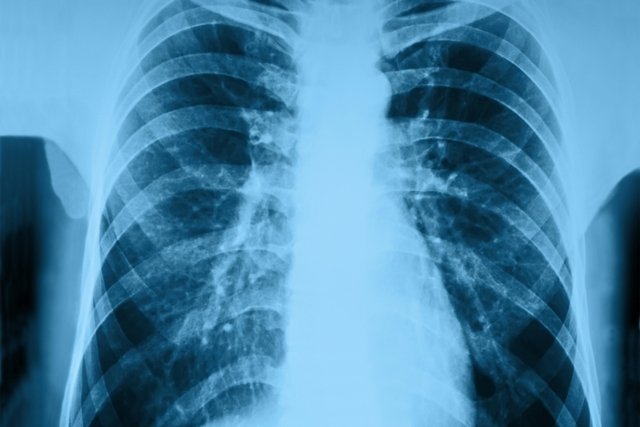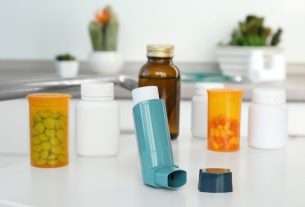Hospital pneumonia is a type of pneumonia that appears 48 hours after admission or up to 72 hours after discharge from the hospital, which means that the microorganism responsible for the infection will have been acquired in a hospital environment.
This type of pneumonia, also known as nosocomial pneumonia, may be related to procedures carried out in the hospital and is mainly caused by bacteria that are present in the hospital environment and that can settle in the lungs, reducing the amount of oxygen and producing respiratory infection. .
It is important that hospital-acquired pneumonia is identified and treated quickly so that complications can be prevented and there is a greater chance of achieving a cure. Therefore, the general practitioner or pulmonologist or infectious disease specialist may recommend the use of antibiotics with the aim of eliminating the microorganism responsible and promoting improvement in symptoms.

Main symptoms
The main symptoms of nosocomial pneumonia are:
- High fever;
- Dry cough that can progress to coughing with yellowish or bloody discharge;
- Easy fatigue;
- Lack of appetite;
- Chest pain;
- Difficulty breathing.
As most cases of hospital-acquired pneumonia occur while the person is still hospitalized, the symptoms are usually immediately observed by the team responsible for the person, and treatment is started immediately afterwards.
However, if symptoms of hospital-acquired pneumonia appear after discharge from hospital, it is important that the person consults the doctor who accompanied them so that an assessment can be carried out, tests can be carried out and, if necessary, the most appropriate treatment can be initiated. Know how to recognize the symptoms of pneumonia.
Causes of nosocomial pneumonia
Hospital-acquired pneumonia is caused by microorganisms that can be found more easily in the hospital due to their virulence factors that allow them to remain in the hospital environment for longer and are not removed by disinfectants normally used in the hospital environment.
The main microorganisms associated with hospital-acquired pneumonia are:
- Klebsiella pneumoniae;
- Enterobacter sp;
- Pseudomonas aeruginosa;
- Acinetobacter baumannii;
- Staphylococcus aureus;
- Streptococcus pneumoniae;
- Legionella sp.;
To confirm hospital-acquired pneumonia, it is necessary to confirm that the infection occurred 48 hours after admission or up to 72 hours after discharge, in addition to carrying out laboratory and imaging tests that help confirm pneumonia and the microorganism associated with it. infection. Find out more about hospital infections.
Who is most at risk
Hospital-acquired pneumonia occurs more easily in people who are undergoing mechanical ventilation, thus receiving the name pneumonia associated with mechanical ventilation, and who have less immune system activity or who have difficulty swallowing, with a greater probability of aspiration of the bacteria that naturally colonize the upper respiratory tract.
How the treatment is carried out
The treatment of hospital-acquired pneumonia must be indicated by a pulmonologist according to the person’s general health status and the microorganism responsible for the pneumonia, with the use of antibiotics normally being recommended to combat the microorganism and reduce inflammation.
Signs of improvement usually appear around the 7th day of treatment, however, depending on the severity of the pneumonia, the person may remain hospitalized during treatment or, in some cases, be discharged. In the latter case, those with the disease can use oral antibiotics at home.
In some cases, physiotherapy may also be indicated, with breathing exercises it can complement treatment with medicines, helping to remove infected secretions and preventing new bacteria from reaching the lungs, and is also used in patients who are hospitalized for a long time, as a way of prevention of nosocomial pneumonia. Understand how respiratory physiotherapy is performed.
Hospital-acquired pneumonia can be contagious and, therefore, it is important that people avoid public spaces such as work, parks or school until they are cured. However, if it is necessary to go to these places, it is recommended that you wear a protective mask, which can be purchased at any pharmacy, or place your hand or tissue in front of your nose and mouth when sneezing or coughing.
See also some exercises that help strengthen the lungs and speed up recovery from pneumonia:

Sign up for our newsletter and stay up to date with exclusive news
that can transform your routine!
Warning: Undefined array key "title" in /home/storelat/public_html/wp-content/plugins/link-whisper-premium/templates/frontend/related-posts.php on line 12
Warning: Undefined array key "title_tag" in /home/storelat/public_html/wp-content/plugins/link-whisper-premium/templates/frontend/related-posts.php on line 13



